New York dressed in 2D. New York in video games – how has The City That Never Sleeps changed?
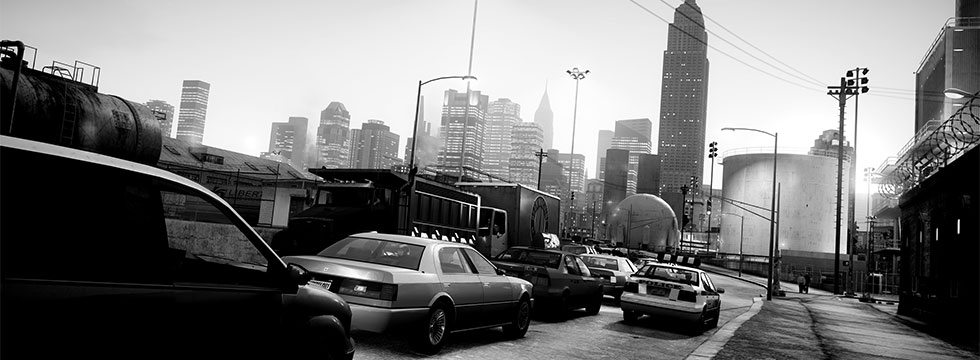
New York dressed in 2D
Thus far, New York was only represented in games by single-color geometric shapes, and the only thing hinting at the identity of the city were the street names. Technical shortcomings did not allow a spectacular rendition of the city’s architecture. The situation started to change by the end of the 80s. In 1988, came out Manhunter: New York by Sierra. This adventure game offered quite an unusual, not to say “surrealistic”, gameplay, as well as a huge dose of graphic brutality in times when no-one had yet heard of PEGI or ESRB. And it featured – finally – some pretty convincing New York locations. The main character, identical to the wizard from the humorous Magicka, fights in first-time-apocalyptic New York. In the city ruined by colossal eyeballs from space, we can see places such as Bellevue Hospital or the Empire State Building. At the turn of the 80s and 90s, a couple of games appeared where NY was only a nice but insignificant touch to a game, like the digital version of the adventures of a certain Kevin who was left home alone; beat’em up games such as Final Fight (where NY appears under a fictional name of Metro City); or Teenage Mutant Ninja Turtles III: The Manhattan Project. In 1997, there came yet another game, ending the 2D era – Grand Theft Auto.
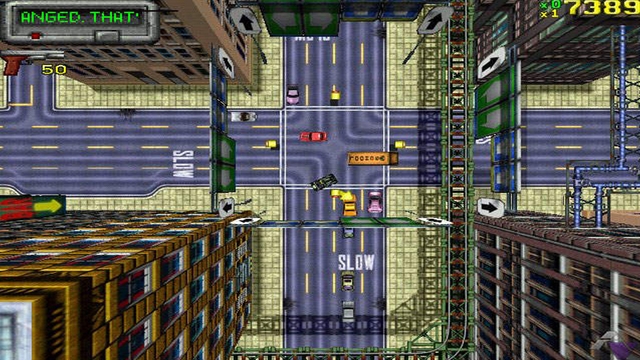
New York in GTA was actually more of a first visit to the fictional Liberty City. However, judging by the contours of the islands, perpendicular grid of the streets, or the names of districts, it’s blatantly obvious what inspired Rockstar. New Guernsey, Brocklyn, Kings, Brix – Liberty City’s districts names are punning their real-world counterparts. There were no iconic locations and buildings in the game though, and, seeing everything from above, we find the yellow cabs the most distinctive element. Rockstar didn’t stop at visuals: based on true events, an alternative version of the history was invented, emphasizing such events as the purchase of the island by Belgian settlers (in reality, the English took Manhattan Island by force from the Dutch), the epidemics in the city, or the economic depression of the 70s. The cultural diversity, and the crime rate issues were also mentioned.
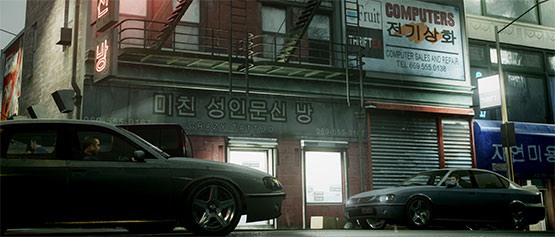
Libery City appears in a total of 9 games from the Grand Theft Auto series, but it isn’t the same consistently depicted city within the same universe in each game. GTA is divided into three eras so far: 2D, 3D, and HD. Liberty City is not only bigger and more diverse in the subsequent games, but the nomenclature changes as well. Digital Brooklyn was known as Portland and Broker. Manhattan becomes Central Island, then Staunton, and eventually Algonquin in GTA IV. Central Park is simply the Park in GTA, Belleville Park in GTA III, and Middle Park in GTA IV. The famous Times Square appears in GTA III as Bedford Point, and Star Junction in GTA IV. Only Little Italy came out untouched, bearing the same name in IV.
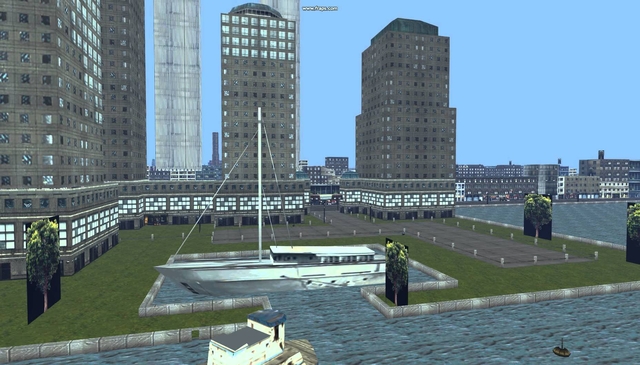
New York gets another dimension
Three dimensional New York first appeared in car games, though the very first was a shooter, not a racing game. In Die Hard Trilogy – a digital adaptation of the movies with Bruce Willis – more precisely, in the third episode – “With a Vengeance” – we took the wheel of a cab, and a police car during a frenzied car chase throughout the New York City – just like John McClane. In spite of the quick pace of Die Hard Trilogy, we could spot characteristic features of NY’s architecture: the tenements with fire escapes, and the tall downtown buildings. In a car, we would also violate the greenery in the Central Park. The streets were already full of pedestrians. An interesting piece of trivia is the fact that the NY level, based on the third movie, was designed as the first one and was supposed to be a stand-alone game itself. However, pressed by the publisher, Fox Interactive, the developers from Probe Entertainment had to add two more episodes – a TPP and a rail shooter. Three years later came out another hit, Drive, aiming at evoking the atmosphere of the silver screen car chases. After taking us to Miami, San Francisco, and LA, the game went on to New York, the home city of the protagonist – Tanner. Driver, at the time, stood out with the sandbox freedom; the virtual Big Apple had never looked so convincing before. The streets thronged with yellow cabs turning at 90 degree intersections. In spite of most of the buildings not being very tall, the NY architecture was recognizable. The city featured not only mandatory icons like World Trade Center, Grand Central Station, Battery Park, or Washington Square, but also spots popular among New Yorkers themselves, such as the Alamo Cube sculpture.
The turn of the 20th at 21st century has also seen two outstanding games, which, although they didn’t revolutionize the visual side of the city and did not allow sandbox freedom of exploration, excelled at conveying the mood of New York, making sure that we remember where we are throughout the whole game. The first one is Deus Ex, 1999. The game takes place in a futuristic, cyberpunk, not too cheerful version of NYC. Playing as agent JC Denton, we visit Liberty Island where the Statue of Libery lies in ruin; Battery park; Hell’s Kitchen district (infamous for high crime rate); and LaGuardia airport. The second game is the sensational Max Payne, 2001, along with its sequel. Because of the distinctive atmosphere, New York is referred to as Noir York City – we always see the city at night, during heavy rain or snowfall. The spectacular shootouts are underlined by a gloomy and dreary image of the city, shown in perfectly recreated hotels, metro stations, and sordid back streets.
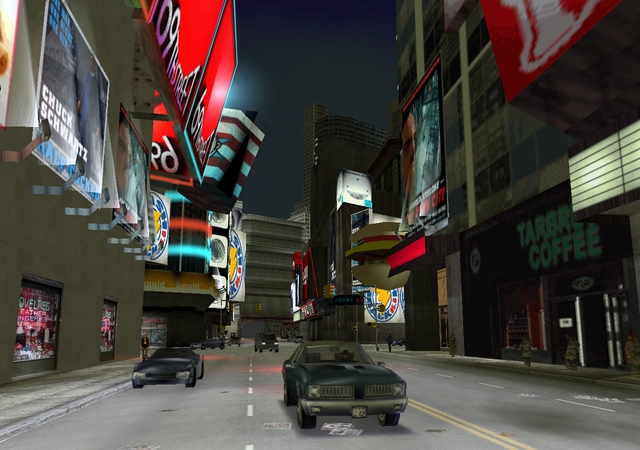
New Liberty Chicago York Philadelphia City 3D
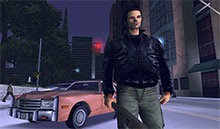
The Liberty City in GTA III had no motorbikes. Reason? We find out in the game that they’ve been banned for the years 1999-2001 to make more room for cars. In reality, implementing them proved too hard for the programmers at that time. There are also traces of multiplayer in the game – Rockstar experimented with it, but the idea was eventually dropped on the account of quicker GTA: Vice City release.
On October 22, 2001, Grand Theft Auto III shook the foundations of the gaming industry. Rockstar managed to convert its flagship series into 3 dimensions, and offered a killer combination of absolute sandbox liberty, linear, absorbing storyline, and compelling gameplay. All this was encased in amazing graphics, displaying the enormous power of PlayStation 2, and complimented with top-notch soundtrack. I could go on forever about GTA III, but our topic is focused elsewhere: is New York featured in that game? In the first GTA, Libery City is certainly the City of New York, just as it sure is in IV. In III we are in Liberty City as well, so it should be safe to assume that it also is New York, shouldn’t it? Well... yes and no. Liberty City in GTA III wasn’t designed with NYC in mind from the very beginning. It was supposed to be a totally fictional, American city, loosely inspired by Phili, Detroit, Chicago, and New York – at least according to the developers. True – we won’t find the Statue of Liberty here, nor a grid of perpendicular streets, nor many iconic locations, but because of such details as the replica of the Flatiron building, colorful neon lights of Bedford Point resembling Times Square, yellow ”Checker” cabs, and – most prominently – the name “Libery City” itself, the same as in the original game, many players were eager to believe that LC in GTA III was indeed New York City. The game was released only a month after the attacks of 9/11, which led to many conspiracy theories about changes made in the layout of the city right before the release of the game.
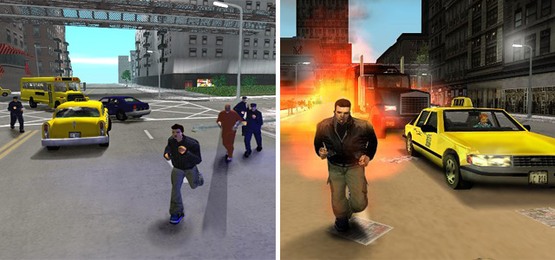
LIBERTY CITYT AFTER THE ATTACKS OF 9/11
Various conspiracy theories regarding the content cut from GTA III and the alleged frenetic removal of NYC similarities flooded the Internet after the game’s release. The elements connecting LC to NYC were the alleged traces of the WTC towers, or the characteristic school buses. Donald Love was meant to die after a plane hit his house, and the Dodo was so hard to control on purpose, so that the players wouldn’t perform similar maneuvers. According to Rockstar’s official statement, after 9/11 as little as 1% of the game was changed: a mission containing terrorists was deleted, cop cars were repainted from white-blue to black to resemble the Los Angeles PD. Part of radio broadcasts was altered, as well as some random pedestrians’ remarks. The cover of the American edition was changed as well, adapting the style that became a symbol of the series after Vice City. That’s the official version, but is there more to it? There are some pictures in the Web showing a very early version of the game, when Rockstar was experimenting with comic-book-like, cell shaded graphics, and the characteristic school buses can be spotted easily.

Road to Liberty City HD
Maybe New York wasn’t in Grand Theft Auto III, but it can’t be denied that the game has become the benchmark for open cities and high quality in general – not only for the consecutive parts of the series, but for all those publishers who wanted their own GTA. Let’s keep in mind that it was Rockstar that published Midnight Club: Street Racing before GTA III and the 9/11 attacks – a racing game in which we rushed a yellow cab through the streets of New York. Such locations as Time Square, Empire State, WTC, UN building, Rockefeller Center, Washington Square and Madison Square Garden were included, and the game pioneered big, open, 3D environments. From 2001 to 2008, the virtual NYC evolved into a vibrant metropolis, with increasingly convincing graphics.

That “almost-New York” from GTA III led to the development of a couple of decent interpretations of the city in GTA’s clones. In 2005, second game of the True Crime series, sub-titled New York City came out, and it copied tons of GTA’s mechanics, also utilizing those found in San Andreas. True Crime boasted the rendition of 40 square miles of Manhattan, with real streets and locations’ names, placed in the game based on GPS data. Players could enter many buildings; you were able to buy clothes, food, go to a drug- or a gun store, as well as buy a car from a showroom. Hotels, clubs, and apartments were open to explore, and we could travel through NYC in cars, cabs, and even the subway. The cast of the game and the soundtrack didn’t lack popular names: Christopher Walken, Mickey Rourke, Laurence Fishburne, Jay Z, Bob Dylan – True Crime was supposed to be the game of the year. Unfortunately, it was a total washout: many technical issues and graphics shortcomings indicated that the game was simply rushed. Low sales ultimately buried the series.
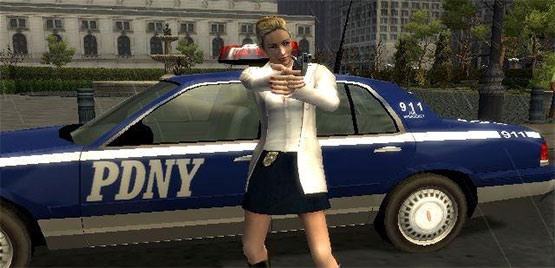
Although a former NYPD detective, Bill Clark, took part in the development of the game, the NYPD Labor Union and the commissioner Rymond Kelly were furious to see the way the game depicted their work. Each copy of the title contained a note stating that the NYPD had nothing to do with the game’s development, and the famous acronym was changed into PDNY.
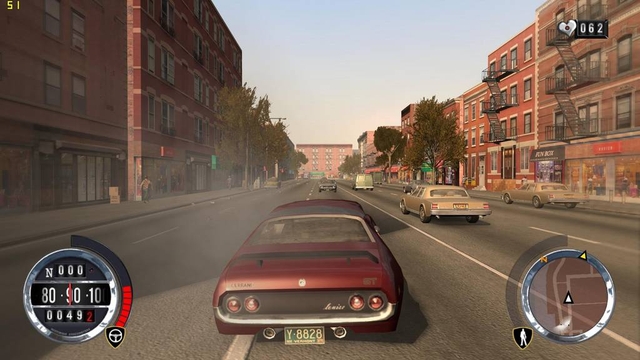
Still, New York was very popular in video games. In the following year came out another game featuring the Big Apple in the role of enormous sandbox – Driver: Parallel Lines. After two parts of the series that were set in different cites, the game came back to New York. There was only one city in the game, but with a nice variation – from the contemporary times, shown in the middle of the game, we went back in time into the 70s, complemented by appropriate music and cars. Contrary to True Crime, here GPS data wasn’t used – instead, a fictional grid of 358km of roads was designed. Keeping in mind the issues of earlier games, the police vehicles were tagged as “City Police”. Driver didn’t use real topography of the city, but it contained a considerable amount of well known buildings. Apart form the obvious locations on Manhattan, such as Times Square, Central Park, WTC, or Flatiron, we were also able to go to Queens, Bronx, Brooklyn, and New Jersey, crossing the river via actual NY’s bridges. New York in Driver: Parallel Lines was truly a living city, with chatting pedestrians, donuts vendors on the streets, and a working subway. The players could choose from several side activities, such as the classic cab driving. However, after releases of Vice City, and San Andreas, Driver seemed more like another GTA-wannabe, and gathered rather moderately enthusiastic reviews.
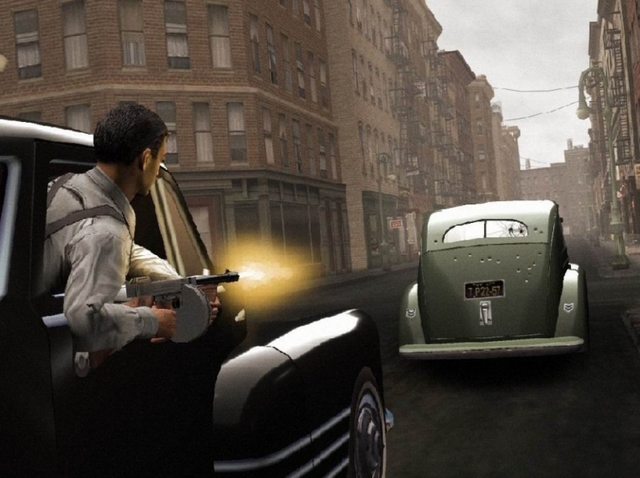
Before the next knock-out-punch by Rockstar Games, only one contestant came out. This time from the EA’s stable. The renown publisher tried a classic this time and approached an adaptation of the story about the king of all mafia stories: The Godfader. The Godfather: The Game is a notable entry in this list since it took us to the New York of the 50s, when only a couple of skyscrapers soared from Manhattan. The topography wasn’t very accurate, but many locations known from the film were rendered in the game; the map was focused on smaller districts: Hell’s Kitchen, Brooklyn, and New Jersey – each controlled by a different family.

New York in videogames is not only racing cars and gang wars. Tycoon: New York allowed us to build and rule the city ourselves. A certain gamer, going by the name of Asterion, pushed things a bit further: he created an incredibly detailed replica of NYC, taking into account most of the buildings, parks, bridges etc. It looks magnificent, and can actually be used as a virtual map for lost or curious tourists.
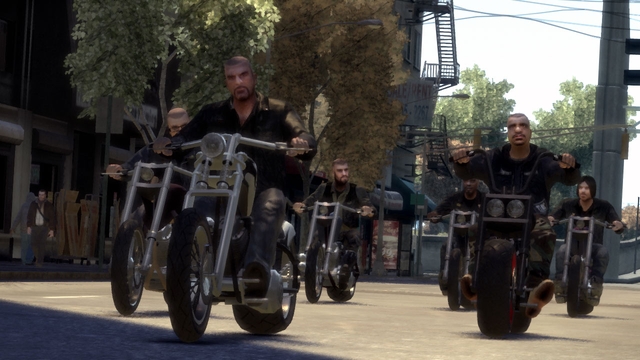
Liberty City HD
The original plan for GTA IV was to implement the entire Liberty State, including everything from rural areas, through mountains, to forests – just like in GTA: San Andreas. Because of time limitations, the devs decided to focus only on recreating the city as best as possible.
In 2008, the virtual New York reached the peak of perfection in what was the fourth installment of the Grand Theft Auto series. While the neighborhoods and buildings were still renamed, the new Liberty City was no longer a cluster of random places from different cities, but the largest and most faithful recreation of New York City in the history of gaming. The developers managed to not only recreate the distinctive cityscapes, streets, famous buildings, and places, but also the overall atmosphere, the aura, the differences between individual neighborhoods, residents, and peculiar people on every sidewalk. You can really feel the urban bustle of the concrete jungle, offering respite only in the few available parks. Typical for the GTA series, the new Liberty City has its history, described in detail from the first settlements, which we learn about watching one of the TV programs in-game; the city has had its mayors, sports teams, crimes, and gangs ruling over neighborhoods. Everything to make the city seem like a giant, living organism.
“New York City is an environment we felt had never been done to the level we were envisioning it in a video game. From looking at all of the locations, this was the one that really stood out to us, and really had that impact. (...) It's not the full city, it's an approximation thereof. We make a city that feels like the real thing, but is perfectly tuned for gameplay in the broadest sense.”
Dan Houser, Vice President of Rockstar Games

The immersion was strenghtened even further by the countless side activities known from previous installments – from the hated bowling with his cousin Roman, through dating, shopping, clubbing, to travelling by public transport. There are many sites on the Internet showing how faithful the places in the game are to their real counterparts, but – interestingly – the New Yorkers have pointed out what Liberty City was lacking. Two things in particular stand out among their complaints: the baseball stadium and bagels. Both are an integral part of the New York culture. The large sports facility would perhaps take up too much space on the map, but the bagels? Niko can eat various meals, including common hot dogs and hamburgers, but the symbol of the city, equal perhaps only to the Empire State Building, is not among them!

Otherwise full of snarky humor and snide comparisons, the game is very careful and tactful when it comes to a very sensitive issue for the New Yorkers, giving up entirely on implementing any traces of the World Trade Center and Ground Zero. However, the creators do not spare Liberty City completely and continue to write its history through the numerous details we can discover in GTA V. It would seem that LC had its 9/11 at some point, as evidenced by the firefighters from Los Santos mentioning the phrase "Never Forget: FDLC" (New York honors the firefighters that died on 9/11 in a similar way), and the online news report of a hurricane that recently devastated the city (a reference to the hurricane Sandy from 2012).

The fire that wasn’t meant to be, and the destruction that came
After Liberty City in GTA IV no one has tried to emulate Rockstar in creating an equally accurate simulation of a living, breathing, detailed New York. This doesn't mean, however, that the other developers will immediately move out of the Big Apple. Several other titles have approached this location somewhat differently, providing us with a bit of respite from the sandbox activities and freedom. In Prototype we simply rampaged in the middle of a fairly simple but convincing recreation of Manhattan; in Alone in the Dark we visited the dark corners of Central Park; in Ghostbusters: The Video Game we recreated the events from the film; and in Forza 3 we raced on tracks set out on the little too wide for that role streets of NYC. 2010's Mafia II evoked inevitable associations with GTA III. While it featured a completely fictional city, Empire Bay, which was loosely based on several American cities, the fact that the famous places from New York were the most high-profile among those inspirations meant that many players perceived the city in Mafia II as a virtual rendition of the city from the 50's. Just as in GTA III, the famous landmarks were renamed: the Brooklyn Bridge became the Grand Upper Bridge, Chrysler Building became Ulver Building, Lincoln Tunnel was Southport Tunnel and the least subtle among them was the Empire Bay Building. In terms of numbers, they are more numerous than the locations borrowed from the Los Angeles area (such as the copy of the Hollywood sign) or Boston, and maybe this is what makes us perceive Empire Bay as another New York. In 2012, Ubisoft decided to aim for originality and gave us the famous city during the time of the American War of Independence in the 18th century. It's hard to find any resemblance or atmosphere similar to that of the modern metropolis, but it is certainly an interesting idea and a breath of fresh air after another visit to the virtual mockups of Times Square and Brooklyn Bridge.
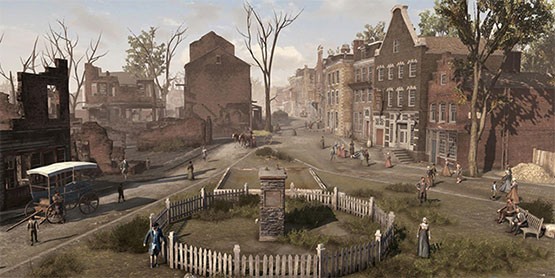
Assassin's Creed III was to show one of the major events in the history of New York, namely the great fire of 1776. The fire broke out at night on August 2 and destroyed one-third of the Manhattan while the rest of the city was being looted. The creators of the game, however, had a problem with the NPC AI that could not convincingly depict their reactions and panic of the citizens facing the fire, so the idea was abandoned.
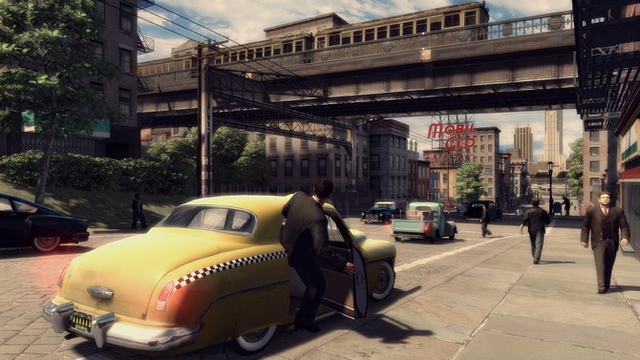
Other AAA titles focused on showing the New York City shattered, bleeding, and a mere shadow of the bustling metropolis we are used to. In Call of Duty: Modern Warfare 3, NYC was where the next world war struck. We watched the burning skyscrapers of Manhattan with the new World Trade Center building in the background, and fought among the rubble of Wall Street and the entire financial district. The developers have also wondered how New York City would look like after a total apocalypse, like in the movie I Am Legend. The second and third part of Crysis excelled at that, depicting the devastated New York as a dreadful concrete jungle, where, despite the destruction and increasingly spreading wild vegetation, one can witness, again and again, the traces of the city's former glory. The famous landmarks are looming somewhere far away in the background or have been completely destroyed, like the head of the Statue of Liberty, currently separated from the rest of its body and left in the drain. And this is where we reach another small revolution in the history of New York's depictions in video games – The Division.
Manhattan on foot
The decision to show New York after the outbreak of a deadly epidemic – desolate, with no passers-by and no traffic – definitely wasn't an easy way out for the creators from Massive Entertainment. They’ve basically decided to truthfully recreate a certain area of the city on a 1:1 scale, and from what we've seen in the game, they succeeded brilliantly. New York in Tom Clancy's The Division is more than famous spots, avenues, blocks, and yellow taxis. Many of those ordinary buildings, providing nothing more than background in other games, have been faithfully recreated in accordance with their true appearance. But that's not all – you can see that even the street lamps not only have exactly the same shape, but are located in the same places as their real counterparts. The size of the buildings and width of the streets – everything seems to be in scale. New York in The Division aims to one up the one in GTA IV. Of course, it was not about a duel between fellow developers. The Big Apple was chosen as the city that is particularly known for being full of life and energy and for its culturally diverse residents. Seeing the metropolis that "never sleeps" destroyed delivers a much stronger and more convincing impact when depicting the total collapse of society and its values. Then, on the occasion of the regular reports on the work progress on The Division, the so called "Map Affair" broke out.
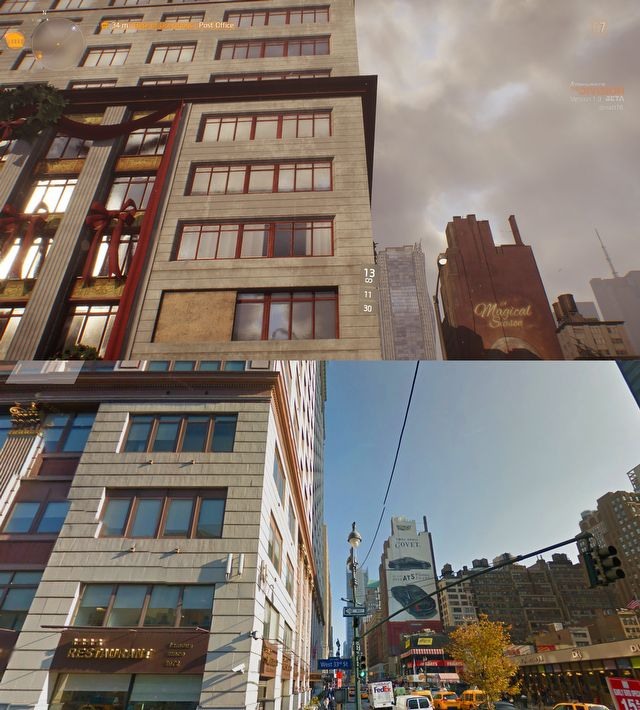
Some players were outraged that the Brooklyn area, seen on the initial teasers and trailers, will not make it to the game, which will ultimately feature only Midtown Manhattan. Although we visit Brooklyn in the game, it’s only for a short while in the prologue. This does not mean that the map is small, because considering the realistic scale of the area and the fact that the game will lack any means of transport except for our own pair of legs – there’s a lot of walking in store for us. It is certain that Midtown Manhattan was planned as the main location of the game from the very beginning; that's where you can find many of New York's iconic locations: the Times Square, the Grand Central, the Empire State Building, the Madison Square Garden, and that’s where the players will spend most of the time in the game. How will The Division's New York grow from there on? Will there be expansions featuring completely separate parts of the city unrelated to the basic game – we'll find out in months to come.
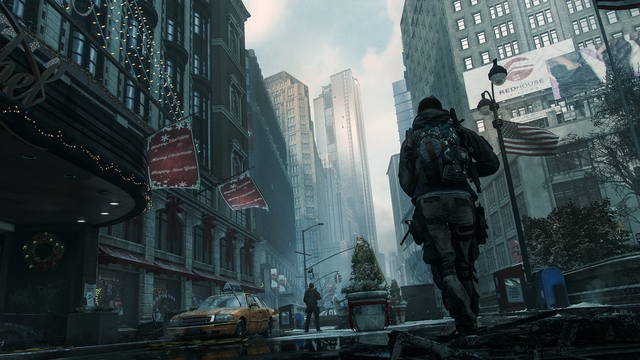
One thing, however, is clear even now – Ubisoft's NYC can boldly stand next to GTA IV's Liberty City. It features a completely different atmosphere and focuses on other details, but the impression it makes is equally striking. What'll come next in video games? A combination of these two concepts: real distances, great graphics and a vibrant metropolis full of pedestrians and traffic jams? Will other cities be featured more often, or will New York remain the developers' favorite? Let us hope that Rockstar haven't yet said their last word, and in some time they will show us again how, according to them, New York a.k.a. Liberty City has changed!
